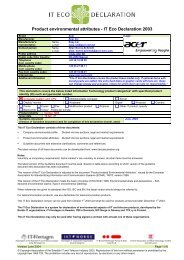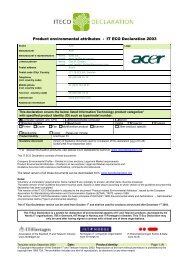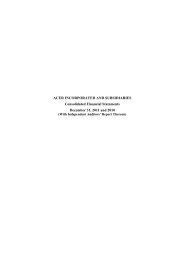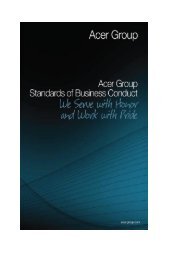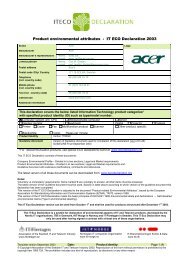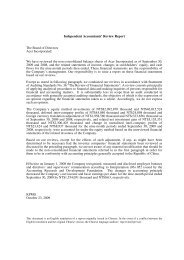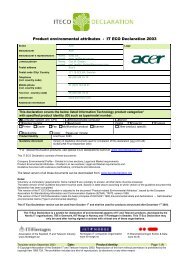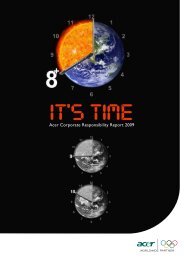Executive Summary - Acer Group
Executive Summary - Acer Group
Executive Summary - Acer Group
You also want an ePaper? Increase the reach of your titles
YUMPU automatically turns print PDFs into web optimized ePapers that Google loves.
2011 <strong>Acer</strong> Corporate<br />
Responsibility Report<br />
<strong>Executive</strong> <strong>Summary</strong><br />
1 2011 <strong>Acer</strong> Corporate Responsibility Report<br />
<strong>Executive</strong> <strong>Summary</strong>
High Level Statement<br />
<strong>Acer</strong> Global Overview<br />
Message from the Chairman & CEO<br />
While the global economy faced tremendous challenges in 2011,<br />
<strong>Acer</strong> underwent personnel reshuffle and organizational change.<br />
We proceeded from corporate governance which includes<br />
enhancing the management system, and promoting independent<br />
and transparent management. <strong>Acer</strong> took the courage reformation.<br />
The organizational change was aimed at overcoming the barriers<br />
between departments, and eliminating the making of decisions<br />
based on the department’s individual interest that may cause a<br />
negative impact on global governance. For <strong>Acer</strong> to realize its core<br />
philosophies and business goals, the company operations need to<br />
be more sustainable and more competitive.<br />
The ICT industry has entered the era of 4C convergence (Computer,<br />
Communication, Consumer electronics and Content services).<br />
Facing the challenges of the global carbon reduction and scarcity of<br />
natural resources, product design trends have shifted. The industry<br />
that used to focus on super-computing power, high-speed graphics<br />
processing, and large memory storage capacity, has now switched<br />
to emphasizing on “mobile computing” capability, ultra-thin, energysaving<br />
and high efficiency notebooks and tablets, as well as cloud<br />
computing. We believe that the new trend is favorable to the<br />
promotion of sustainable development, and ICT technology on the<br />
global carbon reduction will provide a more significant contribution<br />
than in the past.<br />
As a leading ICT brand, the implications of corporate social<br />
responsibility to <strong>Acer</strong> means promoting energy efficiency, low<br />
carbon, fewer resource consumption and responsible management<br />
of chemicals. After all the efforts we made in 2011, <strong>Acer</strong> will strive to<br />
create more energy-efficient products and services to the worldwide<br />
market in order to make a concrete contribution to the Green<br />
Revolution for ICT. We believe this is an opportunity for <strong>Acer</strong>, as<br />
well as a new hope for world sustainability.<br />
Americas<br />
Consolidated<br />
revenue by<br />
region<br />
26.0%<br />
PC shipments<br />
Market share 9.6%<br />
Ranking 3<br />
No.Employees 797<br />
EMEA<br />
Consolidated<br />
revenue by<br />
region<br />
35.4%<br />
PC shipments<br />
Market share 14.2%<br />
Ranking 2<br />
No.Employees 1,910<br />
Asia<br />
Consolidated<br />
revenue by<br />
region<br />
33.1%<br />
PC shipments<br />
Market share 9.9%<br />
Ranking 3<br />
No.Employees 2,542<br />
Taiwan<br />
Consolidated<br />
revenue by<br />
region<br />
5.5%<br />
PC shipments<br />
Market share 23.1%<br />
Ranking 2<br />
No.Employees 2,645<br />
2009 2010 2011<br />
2009 2010 2011<br />
Consolidated<br />
revenue<br />
NT$573.98 B NT$629.06 B NT$475.34 B<br />
PC<br />
shipments<br />
Approx. 39.80<br />
million<br />
Approx. 45.50<br />
million<br />
Approx. 39.50<br />
million<br />
J.T. Wang,<br />
Chairman & CEO<br />
Operating income NT$15.33 B NT$18.20 B (NT$6.40 B)<br />
Net income (loss)<br />
after tax<br />
NT$11.35 B NT$15.12 B (NT$6.60 B)<br />
EPS NT$4.3 NT$5.7 (NT$2.5)<br />
Market share 12.60% 13.00% 11.2%<br />
Global<br />
Market Share<br />
Ranking<br />
2 2 4<br />
2011 <strong>Acer</strong> Corporate Responsibility Report<br />
<strong>Executive</strong> <strong>Summary</strong><br />
2
2011 Goals and Achievements<br />
2011 Goals and Commitments Status Achievements and Details<br />
Corporate<br />
Governance and Stakeholder<br />
Engagement<br />
Continued holding of <strong>Acer</strong> CSR Forum and communication with international<br />
stakeholders.<br />
○<br />
The timing of the Forum was switched from the fourth quarter to the first quarter beginning in 2011 to coordinate with <strong>Acer</strong>’s<br />
global CSR governance mechanism.<br />
Development of an internal corporate responsibility sharing platform. ◎ In development; Completion expected in second quarter of 2012.<br />
Establishment of information platform for supply chain SER management.<br />
Achievement of organizational reform of global CR governance for transferring<br />
existing responsive actions to 2011-2014 strategic actions.<br />
◎<br />
◎<br />
Being done according to the timetable for development of the EICC On supply chain social responsibility platform; suppliers expected<br />
to be asked to join the platform in fourth quarter of 2012.<br />
Following <strong>Acer</strong>’s major personnel reorganization in 2011, corporate governance has been strengthened, and a global CSR committee<br />
has been set up under executive committee.<br />
Improvement of HSF-related trial runs and mass-production on every production<br />
line.<br />
◎<br />
HSF machines are being added to each production line, and ratio of HSF machines on all lines is growing.<br />
Continued participation in international legislative discussions on halogen-free<br />
manufacturing.<br />
● <strong>Acer</strong> participated in discussions on legislation to revise EU’s RoHS, which was completed in July 2011.<br />
Environment and<br />
Energy Managemen<br />
Responsible<br />
Supply Chain<br />
Employee Welfare and<br />
Advancement<br />
Continued participation in CDP Supply Chain Program and improvement of questionnaire<br />
feedback quality.<br />
Participation in domestic and international discussions on and formulation of carbon<br />
footprint standards.<br />
Continued promotion of energy conservation programs in workplace.<br />
Boosting of percentage of medium- and high-risk suppliers audited from 16% to<br />
50%.<br />
●<br />
●<br />
●<br />
<strong>Acer</strong> continued asking major suppliers to join Carbon Disclosure Project (CDP) in 2011; 74 suppliers responded to questionnaire,<br />
for a response rate of 97%.<br />
<strong>Acer</strong> participated in WRI/WBCSD global pilot project for product and value-chain carbon footprint standards, entering models of<br />
netbook, display, and projector, and also joined Enviromental Protection Administration’s “Discover the Carbon Footprint Label”<br />
activity.<br />
When renovating our offices we choose green materials and energy-saving lighting, and install automatic light shutoff systems.<br />
We also promote energy conservation and carbon reduction in public areas; for example, at <strong>Acer</strong>'s Taiwan headquarters , we<br />
have cut greenhouse gas emission by 3.2% in 2011.<br />
◎ SER on-site inspections of 40 suppliers were carried out in 2011.<br />
Increase of percentage of suppliers filling out SAQs to 100%. ◎ Percentage of suppliers filling out SAQs reached 80%.<br />
Provision of suppliers with training and lecture, topics including<br />
: Greenhouse gases, CDP, Conflict minerals, Global trends in SER<br />
Organizing of supply-chain SER meetings.<br />
Requirement for all ODM suppliers to obtain OHSAS 18001 accreditation by 2011<br />
and OHSAS 18001 accreditation by 2012.<br />
●<br />
○<br />
●<br />
Before sending out CDP Supply Chain Program questionnaire, we held a supplier questionnaire capacity-building workshop.<br />
In line with <strong>Acer</strong>’s global CSR governance mechanism, supply-chain SER meetings will be merged with first-quarter 2012 CSR<br />
Forum.<br />
All ODM suppliers have introduced OHSAS 18001 occupational safety and health management system.<br />
Continued implementation of <strong>Acer</strong> <strong>Group</strong> Standards of Business Conduct. ● Standards of Business Conduct have been incorporated into the performance management system.<br />
Formulation and implementation of a global training and development program,<br />
including online training courses.<br />
◎<br />
A global personnel developmetn system has been designed and is being implemented by region as needed.<br />
Conducting of environmental safety and health training. ● 573 new employees were given three hours of training; training will be extended to all employees in 2012.<br />
Implementation of a performance evaluation system.<br />
●<br />
1. Performance management systems have been set up in all regions, and the global personnel databank will be integrated in<br />
2012~2013.<br />
2. The global personnel management policy has been updated in such areas as limits of authority and target management.<br />
Customer Service Continued consolidation of the <strong>Acer</strong> Global Customer Service System (CSS). ● Establishment of this system was initiated in 2010, and it is now in use in Europe, the Middle East, Africa, and the Americas.<br />
Community<br />
Involvement<br />
Promotion of <strong>Acer</strong> Volunteer Team services.<br />
Development of community-centric digital opportunity projects.<br />
●<br />
●<br />
The <strong>Acer</strong> Volunteer Team has provided such volunteer services as environmental protection and concern for disadvantaged<br />
groups, and holds regular donations of funds and blood.<br />
The following digital opportunity projects were initiated in 2011:<br />
Cambodian Digital Opportunity Center, Three Philippine Digital Opportunity Centers, Remote Chinese School Digital Opportunity<br />
Project<br />
● Complete ◎ Partially complete ○ Not complete<br />
3 2011 <strong>Acer</strong> Corporate Responsibility Report<br />
<strong>Executive</strong> <strong>Summary</strong>
Corporate Responsibility<br />
Stakeholder Engagement<br />
Sponsor of CDP pre-launch and launch events in Taiwan<br />
for 4 years running.<br />
Corporate Responsibility Policy and<br />
Strategy<br />
After years of effort, we entered the CSR strategy implementation<br />
stage by setting up a Global CSR Committee to expand the scope<br />
of the company’s internal CSR governance system. We carried out<br />
a re-categorization of key issues, proposing four major orientations<br />
for the next stage of development—environment, society,<br />
governance, and communication (ESGC).<br />
Green Product<br />
Energy & Climate<br />
Take Back<br />
Waste<br />
Water<br />
Report<br />
Web Disclosure<br />
Stakeholder<br />
Engagement<br />
Green Marketing<br />
Socially Responsible<br />
Investing<br />
DJSI<br />
• Corporate Key Aspects and Issues 2011-2014<br />
Corporate Responsibility<br />
Governance<br />
We readjusted our CSR governance and implementing organization<br />
and established a new Global CSR Committee based on<br />
implementation and experience built up over recent years. The<br />
Global CSR Committee must set up relevant strategies at the<br />
beginning of the year, review strategic directions and progress of<br />
implementation in the middle of the year, and carry out an annual<br />
summation and review of programs implemented at the end of the<br />
year.<br />
<strong>Executive</strong> Committee<br />
Global CSR Committee<br />
RO CSR Committee<br />
E<br />
Environment<br />
C<br />
Communication<br />
<strong>Acer</strong> Foundation<br />
Corporate<br />
Sustainability Office<br />
(CSO)<br />
RO CSR Exe.<br />
Secretary<br />
CSR<br />
S<br />
Society<br />
G<br />
Governance<br />
Employee<br />
Supply Chain<br />
Community<br />
Corporate Governance<br />
CSR Governance<br />
Incentives for Green & Low<br />
Carbon Innovation<br />
SMART Strategy<br />
ECGC<br />
Working <strong>Group</strong>s<br />
<strong>Acer</strong> understands that the pursuit of sustainable<br />
development can be carried out successfully only with<br />
the cooperation of stakeholders of all kinds. To this<br />
end we have engaged in a long-term effort to build up<br />
mechanisms and platforms for communication with<br />
stakeholders.<br />
In coordination with the readjustment of <strong>Acer</strong>’s global CSR<br />
governance mechanism, we decided in 2011 to move the annual<br />
<strong>Acer</strong> CSR Forum from the fourth quarter to the first quarter with the<br />
aim of helping more senior managers to understand global trends in<br />
sustainable development and think about <strong>Acer</strong>’s role and strategies<br />
in this regard.<br />
Public Policy Participation<br />
Suggestions on Energy and Climate<br />
Change Policy<br />
In a “weekly journal” interview hosted by ROC President Ma Yingjeou<br />
this year, J.T. Wang, in his capacity as <strong>Acer</strong>’s chairman and<br />
group CEO as well as chairman of the Taipei Computer Association,<br />
suggested to the president that the government should devote more<br />
effort to develop policies to encourage industries to develop green,<br />
low-carbon products. He expressed the hope that in the future, the<br />
government would work actively to provide a market mechanism<br />
under which companies would voluntarily purchase clean energy<br />
and be encouraged to implement energy conservation and carbon<br />
reduction measures. At the end of 2011 the government announced<br />
a “green electricity pricing policy,” which was expected to be<br />
implemented in 2012.<br />
Preventive Management of Chemicals<br />
During the 2009-2011 consultation period for the revision of the EU’s<br />
RoHS, <strong>Acer</strong> cooperated with its allies in voicing to the European<br />
Parliament the hope of having PVC/BFR and other chemical<br />
substances containing organic chloride and organic bromine listed<br />
in the law so as to avoid harming the environment. Although the<br />
final revision has not yet been passed, we hope to take advantage<br />
of the law to implement across-the-board management and carry on<br />
continuing communication and discussion with suppliers and other<br />
stakeholders worldwide.<br />
Support for New Issues<br />
Carbon Disclosure Project<br />
<strong>Acer</strong> and the <strong>Acer</strong> Foundation have provided long-term sponsorship<br />
for the CDP’s promotional activities in Taiwan beginning in 2008,<br />
helping the island’s industries to learn about the latest trends in<br />
carbon control and invite all <strong>Acer</strong> suppliers to participate in these<br />
meetings. In 2011 we started inviting financial experts to participate<br />
and analyze, from the viewpoint of capital markets and institutional<br />
investors, the concerns and attitudes of international stakeholders<br />
in regard to the issue of carbon emissions control.<br />
WRI/WBCSD Global Pilot Project for<br />
Product and Value Chain Carbon Footprint<br />
Standards<br />
In 2011 <strong>Acer</strong> continued leading suppliers and one model each<br />
of netbooks, displays, and projectors in participation in the GHG<br />
Protocol Global Pilot Project for Product and Value Chain Carbon<br />
Footprint Standards as formulated by the WBCSD and WRI, sharing<br />
experiences and suggestions on the carbon footprint inventory for<br />
ICT products to serve as a basis for the setting and improvement of<br />
standards.<br />
Vision 2050<br />
<strong>Acer</strong> responded to Vision 2050 proposal of WBCSD in 2010. At<br />
the end of 2011 we began working, together with companies in the<br />
Taiwan Corporate Sustainability Forum that are concerned with the<br />
issue of sustainability, on formulating a local Taiwan Vision 2050<br />
with the hope of providing companies, the government, and society<br />
with a blueprint and a role definition for the island’s sustainable<br />
development in the future.<br />
The Water Issue<br />
As an ICT product value chain integrator, we held two New Focus<br />
on Management Tools to Develop Sustainable Global Enterprises<br />
seminars this year. A total of 45 enterprises participated in the two<br />
seminars, helping domestic enterprises to understand the new<br />
trends affecting corporate sustainable development.<br />
NS CSR Committee<br />
• Sustainable Development Office Organization<br />
2011 <strong>Acer</strong> Corporate Responsibility Report<br />
<strong>Executive</strong> <strong>Summary</strong><br />
4
Environmental and Energy Recipient of EPEAT gold medals for 31 products 100% of notebook models have received Energy Star certification.<br />
The environmental responsibility facet of our corporate<br />
sustainable development is seen in both our business<br />
operations and product design. We maintain a firm grasp<br />
of the risks and opportunities inherent in climate change<br />
so that we can advance toward our target of becoming a<br />
climate-friendly corporation.<br />
Our Operations and the<br />
Environment<br />
We take the administering of our EHS system very seriously. We<br />
set targets and draw up action plans every year related to improving<br />
EHS performance and try our best to reduce the impact that our<br />
operations have on the environment.<br />
<strong>Acer</strong> Water Plan<br />
As we do not have factories, our primary facilities are offices, and<br />
thus the water we consume is used for typical office-block facilities<br />
such as washrooms and air-conditioning. In 2011 we started to<br />
collect data on our total worldwide consumption of water and arrived<br />
at the figure of 39,000 tonnes. This amount accounted for 63.5% of<br />
our employees.<br />
Capacity<br />
Building<br />
Supply<br />
Chain<br />
Management<br />
Opportunity<br />
&<br />
Innovation<br />
Concept<br />
Building<br />
Training<br />
• <strong>Acer</strong> Water Plan administrative procedures.<br />
Accounting<br />
Water Footprint<br />
Risk Mapping<br />
Priority<br />
Strategy &<br />
Stakeholder<br />
Engagement<br />
Establish for Management and Innovation Capacity<br />
Toward an Advanced & Competitive Global Company<br />
Water issues are becoming more prominent by the day and this<br />
will bring both direct and indirect challenges to our commercial<br />
development. We have thus drawn up the <strong>Acer</strong> Water Plan, and<br />
marks the first time that we have employed the Global Water Tool<br />
developed by the WBCSD to conduct water resource risk analysis<br />
at all <strong>Acer</strong> operations centers globally. It was found that over 50%<br />
of our operations centers are situated in areas that are “extremely<br />
likely” to face water shortages in the future.<br />
Product Design that Incorporates<br />
Environmental Considerations<br />
Here at <strong>Acer</strong> we are continually trying to reduce the environmental<br />
impact of our products beyond just adhering to government<br />
regulations. By reducing the environmental impact of our products<br />
at every stage of their life-cycle, we are helping our customers to<br />
save time and resources and live and work in a more sustainable<br />
way.<br />
Raising Energy Efficiency<br />
Being in accordance with the EU’s ErP directive is the basic energy<br />
efficiency requirement of all <strong>Acer</strong> products, including for “powerdown”<br />
and “switch off” functions, and for external power supply<br />
equipment. In 2011 all of our range of notebook computers was<br />
accredited by ENERGY STAR®, and from 2012 all of our monitors<br />
will carry the ENERGY STAR label. The <strong>Acer</strong> range of notebooks<br />
now also have screens that use energy-saving LED backlighting.<br />
We believe that raising the energy efficiency of our products is a<br />
big part of our responsibility to the citizens of the world and future<br />
generations to come.<br />
Properly Managing Chemical Substances<br />
In terms of managing chemical substances, all <strong>Acer</strong> products are<br />
now fully accordant with the requirements of the EU’s RoHS and<br />
REACH directives. In fact, in our enthusiasm to be eco-friendly<br />
we have taken the principle of preemption a step further and now<br />
have a system of mutual chemical substance management with our<br />
suppliers.<br />
Out of the many voluntary environmental protection standards,<br />
the EPEAT standards are becoming more prominent due to their<br />
successful global development. EPEAT encourages the use of<br />
plastic regrind, which increases the distribution of materials from<br />
recycled electronic products. We are working hard to overcome<br />
managerial and technical challenges to reduce the number of these<br />
hazardous substances – permitted though they may be – so that our<br />
products meet EPEAT’s strict standards. In 2011, 31 of our products<br />
were awarded the EPEAT Gold and 61 of them were awarded their<br />
Silver.<br />
In addition to EPEAT we are also eagerly applying for voluntary<br />
environmental labeling or accreditation in a number of countries<br />
around the world, including accreditation for energy saving from<br />
the China Standard Certification Center, China’s Ten Central<br />
Certification, Taiwan’s Green Mark, and TCO certification. Attaining<br />
certification is an important way of proving our commitment to<br />
environmental protection.<br />
Advancing Eco-Efficiency of Product<br />
Packaging<br />
<strong>Acer</strong> product packaging design aims to reduce all areas of<br />
environmental impact by taking a “whole life cycle” approach. We<br />
do our best to reduce packaging material, use recycled materials<br />
and restrict hazardous substances, while adopting sustainable<br />
packaging principles to guide the design of our product packaging.<br />
We have initiated corresponding actions for each of our product<br />
lines to reduce the use of paper and packaging.<br />
• Tablet PC: From August 2011, instead of providing paper with<br />
printed instructions on starting the computer, we now provide<br />
this information on a document that can be downloaded from<br />
our website.<br />
• Notebook PC: From 2010, we reduced the use of manual pages<br />
by 80%, downsizing from 102 pages to 12 pages.<br />
• Desktop PC: From 2007, European and US regions no longer<br />
provide a user’s manual and have reduced the weight of paper<br />
used in other documents from 80 grams to 70 grams.<br />
• Monitors: From September 2010, user’s manuals are no longer<br />
provided for 95% of monitor products; from 2011 over 40% of<br />
LED monitors were packaged with cardboard of new design<br />
which reduces overall packaging volume by 40%.<br />
To attain our goals for using reusable packaging materials, all<br />
external packaging of notebook PCs is made from recycled paper<br />
and from 2009 all notebook PCs have been wrapped in reusable<br />
felt.<br />
5 2011 <strong>Acer</strong> Corporate Responsibility Report<br />
<strong>Executive</strong> <strong>Summary</strong>
Green Product Innovation<br />
Energy and Climate Change<br />
Response<br />
Climate change is at once both risk and opportunity for the ICT<br />
industry. The industry must not only work to reduce its own<br />
emissions, but also must stay attuned to the risks climate change<br />
pose to its operations, while creating opportunities for other sectors<br />
to apply ICT toward carbon reduction initiatives.<br />
Greenhouse Gas(GHG) Inventory<br />
The total GHG emissions from worldwide offices and operations in<br />
2011 amounted to 53,008.78 tonnes of carbon dioxide equivalents,<br />
which is further divided into three scopes. Scope 1 emissions are<br />
mainly fuel combustion and fugitive refrigerants. Scope 2 comprises<br />
the largest contributor of emissions at 73% of the total, and are the<br />
indirect emissions from the electricity used to operate our offices<br />
and points of operation. Scope 3 emissions are transportation<br />
related emissions caused by the airplane travel of our staff, and<br />
accounted for 15% of total emissions in 2011.<br />
7,901.35<br />
15%<br />
38,762.63<br />
73%<br />
6,344.80<br />
12%<br />
• 2011Greenhouse Gas Emission form Worldwide Operations<br />
(Unit: Tonnes of Carbon Dioxide Equivalents)<br />
2011 <strong>Acer</strong> Corporate Responsibility Report<br />
<strong>Executive</strong> <strong>Summary</strong><br />
■ Scope 1<br />
■ Scope 2<br />
■ Scope 3<br />
We readjusted our inventory boundary to proportionally divide all<br />
of the eDC electricity use into two parts: emissions generated from<br />
the client’s independent electricity use is categorized under the<br />
client’s Scope 2 emissions, while emissions generated from nonclient<br />
independent electricity use is categorized under <strong>Acer</strong>’s Scope<br />
2 emissions. This boundary adjustment created a major difference<br />
in our overall emissions and thus we started back at the baseline<br />
year to recalculate GHG emissions of global operations from 2009<br />
to 2011, as shown in the following chart.<br />
60000<br />
50000<br />
40000<br />
30000<br />
20000<br />
10000<br />
0<br />
42,860.32<br />
2,900.97<br />
36,754.66<br />
3,204.69<br />
2009<br />
• 2009-2011 <strong>Acer</strong>’s global GHG emissions from offices and other<br />
operations. (Units: tonnes of carbon dioxide equivalents)<br />
GHG Reduction<br />
49,237.63<br />
5,453.18<br />
40,279.77<br />
3,504.68<br />
2010<br />
53,008.78<br />
7,901.35<br />
38,762.63<br />
6,344.80<br />
2011<br />
■ Scope 1<br />
■ Scope 2<br />
■ Scope 3<br />
<strong>Acer</strong> has always supported the two GHG absolute reduction<br />
targets set forth by the EU, that is, for industrialized nations to<br />
reduce emissions 30% (with 1990 as the baseline year) by 2020<br />
and 50% by 2050. We aim to meet these goals through internal<br />
energy efficiency upgrades, investments in renewable energy, and<br />
procurement of green energy.<br />
Recording energy consumption of 1,200,000 kWh in 2011, <strong>Acer</strong><br />
Germany took the lead in procuring certified renewable energy to<br />
offset all 649 tonnes of carbon dioxide equivalents from energy<br />
consumption. This offset plan won the TÜV NORD certificate and<br />
became the highlight of <strong>Acer</strong> Europe as the first carbon-neutral<br />
initiative for power consumption. From October 2011 <strong>Acer</strong> Italy<br />
cooperated with the local E-Piu renewable energy supplier to use<br />
green power, while saving approximately 800 tonnes of carbon<br />
dioxide equivalents and 12.5% of electricity costs.<br />
<strong>Acer</strong> e-Enabling Data Center<br />
A data center can be a considerable power consumer as it must<br />
maintain system stability 24 hours a day. Since its establishment,<br />
<strong>Acer</strong> e-Enabling Data Center has surpassed industrial energy<br />
consumption standards and provided clients with the most energy<br />
efficient service.<br />
While maintaining the operation of our renewable energy generation<br />
systems, we also look for ways to improve the efficiency of<br />
existing operations. For example, in 2011 we launched a project<br />
to reduce the escape of air from our air conditioners and increase<br />
the efficiency of air circulation. It is estimated that over 900,000<br />
kWh can be saved each year as well as over NT$2 million in<br />
electricity fees – truly a win-win situation both economically and<br />
environmentally.<br />
In the latter half of 2011, we satisfied consumer<br />
demands for rapid start-up, internet connection and<br />
portability with the introduction of the Ultrabook Aspire<br />
S series.<br />
This model is under 1.35 kg and features a unique heat dissipation<br />
and ventilation system as well as a lightweight exterior and the<br />
capacity to maintain continuous stand-by for up to 50 days. The<br />
Ultrabook Aspire S series uses smart energy-saving technology to<br />
greatly increase battery longevity; this technology enables batteries<br />
to be recharged 1000 times, a 3.3-fold increase over the 300<br />
charges of standard lithium battery and open-cell display technology<br />
to reduce metal used. If five million Aspire S series Ultrabooks with<br />
the innovation technology were to replace traditional notebook<br />
computers, the result in terms of carbon reduction would be<br />
equivalent to plant 30 million trees.<br />
Energy Consumption Comparison<br />
<strong>Acer</strong> Aspire S3<br />
Normal Use: 6 W/h<br />
Sleep Mode: 0.28 W/h<br />
Hibernation: 0.015 W/h<br />
VS<br />
Air enters through spaces<br />
between keys in the keyboard<br />
to directly cool down hot<br />
components, and make the most<br />
efficient use of overall power<br />
consumption.<br />
Traditional Notebooks<br />
Normal Use: 8 W/h<br />
Sleep Mode: 0.35 W/h<br />
Hibernation: 0.03 W/h<br />
Smart design concentrates<br />
heat sources and diverts<br />
heat more effectively.<br />
6
Responsible Supply Chain<br />
Conducts on-site audits for 40 suppliers.<br />
We realize the important role that a branded company has to<br />
play in the social and environmental impact of its suppliers.<br />
<strong>Acer</strong> not only demands that all of its suppliers operate within<br />
local regulations and according to <strong>Acer</strong>’s own in-house<br />
policies, but also informs suppliers about the latest trends<br />
in social and environmental responsibilities so they can<br />
build their capacity to meet the challenges of sustainable<br />
development.<br />
On-site Audits<br />
<strong>Acer</strong> has adopted the Electronic Industry Citizenship Coalition<br />
(EICC) code of conduct to guarantee that the manufacturing<br />
operations of our suppliers accord with their social and<br />
environmental responsibilities, and that their employees are<br />
treated with respect and dignity. <strong>Acer</strong> is committed to promoting<br />
social responsibility by improving the labor rights, business ethics,<br />
environmental safety and health practices of the electronics industry<br />
supply chain. We have carried out EICC on-site audits for 40 higher<br />
risk suppliers in 2011 and taken corrective actions for issues found.<br />
Compliance of the EICC Code of Conduct<br />
L&E MS<br />
Environment<br />
Health & Safety<br />
Labor<br />
Ethics<br />
H&S MS<br />
82% 11% 6%<br />
85%<br />
87%<br />
92%<br />
92%<br />
93%<br />
The EICC Validated Audit Process<br />
1% 14%<br />
6% 6%<br />
4% 4%<br />
6% 2%<br />
4% 3%<br />
Compliance Minor Major<br />
We believe that participation in such a Labor & Ethics Lead Auditor<br />
Course from IRCA-EICC-GeSI (International Register of Certificated<br />
Auditors,IRCA) of the EICC Validated Audit Process (VAP) can<br />
increase our understanding of VAP and enhance the quality and<br />
effectiveness of our audits. To this end, in 2011 we were able to<br />
persuade the only organization in the world offering this kind of<br />
training – Verité – to hold a course in Taiwan. We also invited our<br />
suppliers to take the workshop with us in order to raise auditing<br />
competence and quality throughout our supply chain. Seven<br />
suppliers did send staff from different departments to participate in<br />
the course<br />
Top Five Areas of Non-compliance<br />
EICC<br />
Provision<br />
Improvement<br />
Objectives<br />
Young<br />
Workers<br />
Working<br />
Hours<br />
Industrial<br />
Hygiene<br />
Issue<br />
Suppliers are not<br />
implementing<br />
the appropriate<br />
procedure to establish<br />
performance objectives<br />
and implementation<br />
plans of labor and<br />
ethics.<br />
Young workers<br />
exceeded the<br />
prescribed limit for<br />
overtime hours.<br />
Workers exceeded<br />
the prescribed limit for<br />
overtime hours and<br />
worked an average of<br />
seven days without a<br />
day off.<br />
Personal protective<br />
equipment missing or<br />
is not used<br />
Actions<br />
We require suppliers to<br />
develop specific labor<br />
and ethical performance<br />
objectives and<br />
implementation plans<br />
according to procedures,<br />
and implement it.<br />
We require suppliers<br />
to establish an<br />
overtime warning<br />
function in their staff<br />
management system<br />
and propose a working<br />
hour management and<br />
improvement plan.<br />
We require suppliers<br />
that workers must wear<br />
the required personal<br />
protective equipment<br />
and receive risk<br />
education to ensure the<br />
proper use of personal<br />
protective equipment as<br />
well as monitoring by<br />
managers.<br />
Response to Conflict Mineral<br />
We are deeply concerned about the social and environmental<br />
issues related to the materials contained within product parts<br />
and to the manufacturing process. The rich mineral resources in<br />
the Democratic Republic of Congo (DRC) have fueled one of the<br />
world’s deadliest conflicts. There are often multiple sources for<br />
metals including recycled metal, metal inventories and crude ore.<br />
However, we understand we have the opportunity to have a positive<br />
impact on this complex issue as an individual company, and we<br />
support the legislation of related regulations.<br />
We adopted EICC/GeSI Due Diligence Template tool to investigate<br />
which companies refine our supply of tantalum, tin, tungsten, and<br />
gold in 2011. The preliminary analysis indicated the companies<br />
that refine gold, tantalum, and tin are mainly located in China,<br />
Japan and USA. Tungsten, on the other hand, is located mainly in<br />
China and Indonesia. We’ll continue to cooperate with the EICC/<br />
GeSI Extractives working group to support EICC/GeSI Conflict-free<br />
Smelter (CFS) Program.<br />
Supplier GHG Management<br />
We use using the weight of our influence as a large branded<br />
corporation to organize a GHG working group among our major<br />
suppliers. This team conducts regular carbon data tracking, which<br />
is a valuable aid to cultivating the GHG management capabilities of<br />
our suppliers. In addition, <strong>Acer</strong> is also participating in a number of<br />
external carbon reduction-related initiatives that when internalized<br />
should prove useful in facilitating a greener, low-carbon supply<br />
chain.<br />
Carbon Disclosure Project – Supply Chain<br />
Program and EICC Carbon Reporting<br />
System<br />
In 2011 <strong>Acer</strong> continued to require that our major suppliers take<br />
part in our Carbon Disclosure Project – Supply Chain Program. A<br />
total of 74 suppliers were asked to submit questionnaires through<br />
an online response system, attaining a response rate of 97%.<br />
<strong>Acer</strong> intends to continue improving supplier carbon disclosure and<br />
actual performance figures. We will also continue to ask our Tier 1<br />
suppliers to participate in the EICC Carbon Reporting System and,<br />
through participation in international mainstream external initiatives,<br />
getting a firmer grip on<br />
Supply Chain GHG Working <strong>Group</strong><br />
In 2011 our Tier 1 suppliers of smart handheld devices, projectors,<br />
and monitors were included in the Supply Chain GHG Working<br />
<strong>Group</strong>, and the scope of carbon disclosure was expanded to include<br />
Tier 2 suppliers.. We also continue requesting our Tier 1 suppliers<br />
to send in quarterly GHG emissions data for all <strong>Acer</strong> products they<br />
manufacture or assemble. This includes their own emissions data,<br />
plus that of Tier 2 suppliers – such as key component manufacturers<br />
– that they deal with. We also intend to begin requesting our major<br />
suppliers to draw up mid- and long-term carbon emissions reduction<br />
plans and to regularly compile data on their emissions reduction<br />
performances so that we can build up a complete picture of carbon<br />
reduction results for the whole of our supply chain.<br />
7 2011 <strong>Acer</strong> Corporate Responsibility Report<br />
<strong>Executive</strong> <strong>Summary</strong>
Dealer<br />
Care<br />
Employee Advancement<br />
Provided education and training for 7,921 people worldwide, accounting for over 62,000 hours of training time.<br />
<strong>Acer</strong> strives to upgrade employees’ professional<br />
abilities and career development through systematic<br />
training and staff development projects.<br />
At the end of December 2011 <strong>Acer</strong> employed 7,894 persons<br />
worldwide, including 202 managers, 7,036 professionals, and 656<br />
administrators. Their average age was 37.2 years and average<br />
seniority was 5.4 years.<br />
Personnel Training and Career<br />
Development<br />
The focus of our training was adjusted in line with <strong>Acer</strong>’s strategic<br />
repositioning in 2011 to give added emphasis to employee<br />
growth and strengthen core competence, thereby assuring the<br />
effective implementation of the Company’s strategies. Our training<br />
priorities in 2011 included the creation of value for customers<br />
through innovation, boosting of the efficiency of implementation<br />
by reinforcing process management, strengthening brand image<br />
by enhancing product quality, and moving from “push” to “pull” in<br />
marketing.<br />
Male Female Total<br />
No. of Trainees 4,807 3,114 7,921<br />
Total Person-Hours<br />
of Training<br />
Average Hours of<br />
Training per Trainee<br />
39,941 22,573 62,514<br />
8.31 7.25 7.89<br />
Each employee can upgrade his or her professional competence<br />
through a diverse range of development paths. Internally, these<br />
paths include on-the-job training, job coaching, job transfers,<br />
lectures, online learning, and study groups. Externally, employees<br />
can participate in professional seminars as well as short-term<br />
training at prominent universities and training institutions. We<br />
have also formulated “Incentives for Professional Certification<br />
” to encourage employees to upgrade their skills and achieve<br />
professional certification by providing incentives and subsidies to<br />
cover the cost of professional certification.<br />
Training Framework<br />
Managerial Skills<br />
Typical training courses include leading change at the senior<br />
management level; coaching and communication; building<br />
high-performance teams at the intermediate management<br />
level; and enhancing fundamental management competence<br />
at the supervisor level.<br />
General Training<br />
Courses<br />
Customer<br />
Service<br />
4<br />
3<br />
2<br />
1<br />
To satisfy our customers we work proactively to<br />
understand their needs and constantly introduce<br />
products that are better and easier to use. Our aim is<br />
to provide customer services which meet or exceed<br />
the expectations of our customers and create greater<br />
value for them.<br />
<strong>Acer</strong> <strong>Group</strong> Service Model<br />
Professional<br />
Training<br />
New-hire Training<br />
Provider of <strong>Acer</strong> E-Academy, which<br />
has over 8,000 users amongst<br />
staff and partners.<br />
The <strong>Acer</strong> <strong>Group</strong> Service Model is unique in today’s IT industry. In<br />
addition to operating service centers around the world, the <strong>Acer</strong><br />
<strong>Group</strong> also partners with Authorized Service Providers wherever<br />
required. The four key attributes of this model are:<br />
• Hybrid model - Own facilities and operations complemented by<br />
a network of partners.<br />
• Self-owned IT system: ‘One Company, One System’ - Allows<br />
seamless real-time links among all service entities.<br />
• Spare parts logistics – Central and local inventory managed by<br />
one single system.<br />
• Multiple brands – Meets the brand requirements (<strong>Acer</strong>, Packard<br />
Bell, Gateway, eMachines, and Founder) of specific customers<br />
across the globe.<br />
When a customer’s product requires repair, whether it is in Milan;<br />
Kuala Lumpur; Temple, TX; or the location of any other <strong>Acer</strong> Repair<br />
Center, it will be subjected to the same repair process, under the<br />
same rigid quality standards. Almost 60% of our global repair<br />
volume is handled directly by <strong>Acer</strong>, giving us total control over the<br />
operations and assuring the highest standard of repair quality.<br />
<strong>Acer</strong>’s Customer Service System<br />
To further enhance the quality of customer service, we have<br />
developed the Customer Service System as a home-grown suite<br />
of programs that provides one unified system for management of<br />
repair centers, authorized service providers, third-party maintenance<br />
partners, contact centers, parts planning and warehouse<br />
management. It also manages various other web-based customer<br />
interactions.<br />
Suppliers &<br />
Vendars<br />
• CSS Overview<br />
<strong>Acer</strong> Internal<br />
Spares<br />
Hub<br />
Repair<br />
Centers<br />
Suppliers<br />
APS’s<br />
Repair<br />
Centers<br />
Product<br />
LifeCycle<br />
Management<br />
Parts<br />
Logistics<br />
System<br />
<strong>Acer</strong> <strong>Group</strong><br />
Employees<br />
Demand<br />
Planning<br />
System<br />
International<br />
Travelers<br />
Warranty<br />
Backend<br />
Innovative<br />
Contibution<br />
on Service<br />
Head Quarters<br />
Customer Service<br />
Division<br />
Service<br />
Information<br />
Center/AFR<br />
Customer<br />
Complaints<br />
Escalation<br />
Management<br />
System<br />
Extended<br />
Warranty<br />
Integrated<br />
Warranty<br />
System<br />
Service Reporting<br />
Customer Service<br />
Systems<br />
Carriers<br />
Customer<br />
Registration<br />
Call Center/<br />
Repair Center<br />
System<br />
Call<br />
Centers<br />
Customers<br />
Self<br />
Registration<br />
Customer<br />
Self<br />
Service<br />
ASP<br />
System<br />
<strong>Acer</strong> Internal<br />
Repair<br />
Centers<br />
Web<br />
Support<br />
Thrid Party<br />
Managed<br />
Repair<br />
Dealers<br />
Authorized<br />
Service<br />
Provider’s<br />
Dealers, Distributors and External Partners<br />
2011 <strong>Acer</strong> Corporate Responsibility Report<br />
<strong>Executive</strong> <strong>Summary</strong><br />
8
Community Involvement<br />
Community involvement worth approx. NT$ 220,850,000 Provided access to 8,374 people through <strong>Acer</strong>'s Mobile Digital Classroom.<br />
Provided access to Participated in European "Schoolnet Educational Netbook Pilot Project," serving over 7,000 students.<br />
Ever since their establishment, <strong>Acer</strong> and the <strong>Acer</strong><br />
Foundation have used their technology and their<br />
products, the abilities of their staff, and their donations<br />
to give back to society.<br />
The total value of <strong>Acer</strong>’s global community participation in 2011<br />
was approximately NT$220.85 million and was focused primarily on<br />
education, <strong>Acer</strong> volunteer work, disaster relief, and environmental<br />
conservation, with special attention in education work given to<br />
enhancing digital opportunities for disadvantaged groups.<br />
• Upgrading Digital Opportunity in Remote Areas<br />
• Digital Opportunities for Remote Schools in China<br />
• Philippine Digital Opportunity Centers<br />
• <strong>Acer</strong> Digital Vans<br />
• Combodia Digital Center<br />
• Women’s Information Ability Enhancement Project in Italy<br />
Disaster Relief<br />
Major disasters can affect all of society and even the whole country.<br />
When such disasters occur, as members of their communities,<br />
<strong>Acer</strong> and <strong>Acer</strong> volunteers cooperate with local humanitarian relief<br />
organizations in contributing needed resources and manpower<br />
to support community reconstruction. In 2011 our global disaster<br />
relief activities provided help following the Japanese tsunami, Thai<br />
flooding, American flooding, and Philippine typhoons.<br />
Products<br />
75%<br />
Cash<br />
25%<br />
• Donation Type<br />
Commercial Initiative<br />
in the Community<br />
33%<br />
Community<br />
Investment<br />
13%<br />
• Community Donation<br />
Education<br />
Charitable<br />
Donations<br />
54%<br />
We serve students, teachers, women, and other disadvantaged<br />
groups in remote areas through the development of computerassisted<br />
instruction, increasing their opportunities to come in contact<br />
with computers and study them; and encouraging them, in this way,<br />
to use e-learning to boost their digital competitiveness and further<br />
helping them prepare to compete in the information economy.<br />
• European Educational Netbook Project<br />
• Upgrading the Information Ability of Indonesian Teachers<br />
<strong>Acer</strong> Volunteers<br />
<strong>Acer</strong> Taiwan’s volunteer team holds regular internal employee<br />
donation activities every year, as well as blood donation and LOHAS<br />
environmental protection activities at <strong>Acer</strong>’s headquarters in Xizhi<br />
during Earth Months each year. In their community involvement,<br />
<strong>Acer</strong> volunteers organize all kinds of community service activities<br />
every year, and <strong>Acer</strong> employees are encouraged to use their<br />
volunteer leave to participate. In 2011 these activities comprised<br />
two major categories, environmental protection and care for<br />
disadvantaged groups, with a total of 115 employees participating.<br />
Our regional offices<br />
also organized their<br />
own volunteer activities<br />
in 2011. For instance,<br />
<strong>Acer</strong> Thailand invited<br />
its employees to record<br />
audio books for the blind,<br />
and within five months 17<br />
books were produced and<br />
donated to foundations<br />
for the blind. The CSR<br />
Club organized by the<br />
employees of <strong>Acer</strong> India<br />
continued to carry out energy conservation, carbon reduction and<br />
community service activities. When natural disasters happened,<br />
<strong>Acer</strong> employees in different places immediately joined local<br />
volunteer efforts to help the disaster areas weather their difficulties.<br />
• Futaba-machi residents used <strong>Acer</strong><br />
computers to communicate with the<br />
• Awards were presented to<br />
outstanding “15 Green Days with<br />
Environmental Conservation<br />
We promote environmental conservation concepts through our<br />
volunteer activities. The <strong>Acer</strong> Taiwan volunteer team, for example,<br />
organizes environmental conservation activities; <strong>Acer</strong> Singapore<br />
participates in Earth Hour; <strong>Acer</strong> India holds an Environment Week;<br />
and in Japan we provide a temperature-sensitive calendar. We<br />
also work with non-profit organizations to strengthen environmental<br />
awareness among the public and <strong>Acer</strong> employees by holding<br />
environmental activities.<br />
In Vietnam we held “15 Green Days with <strong>Acer</strong>” , a 42-day “PC4Life<br />
– Trans-Vietnam Green Journey” through 16 provinces, and<br />
sponsored a “Green Business Forum”. In the Philippines we build<br />
an “<strong>Acer</strong> Bamboo Greenhouse” cultivate tree seedlings and also to<br />
be used by the community and by <strong>Acer</strong> employees as a place for<br />
environmental education.<br />
9 2011 <strong>Acer</strong> Corporate Responsibility Report<br />
<strong>Executive</strong> <strong>Summary</strong>
www.acer-group.com<br />
To learn more information, please visit <strong>Acer</strong> <strong>Group</strong>'s Sustainability website or view<br />
our complete 2011 Corporate Responsibility Report.<br />
10 2011 <strong>Acer</strong> Corporate Responsibility Report<br />
<strong>Executive</strong> <strong>Summary</strong>



